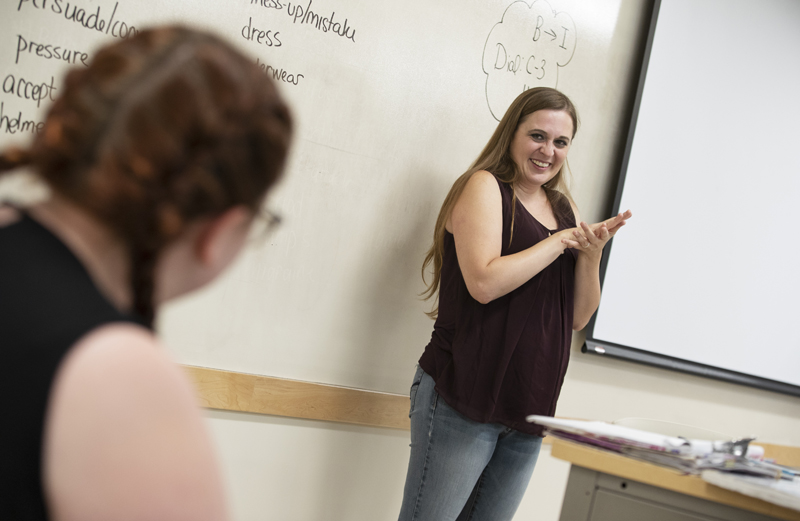American Sign Language classes inspire students, alumni
Courses help spread knowledge of deaf culture and community

For senior Aditya Roy, taking American Sign Language courses at Binghamton University helped him learn that his deafness is not a disability.
“I’m deaf; I was born deaf. I was not comfortable with the word deaf, but after taking three semesters of ASL, I realized it is something I should be OK with,” said Roy, a biochemistry major. “I thought that I had to somehow fit in, and after learning about deaf culture I realized that you don’t have to fit in all the time. I used to feel embarrassed about being deaf because I thought it was a weakness. [This class] shows that this is not a weakness. It gave me some confidence.”
Roy was one of 200 students enrolled in American Sign Language classes during the 2017-18 school year. Offered through the University’s linguistics program in Harpur College, these classes help build bridges across communities and careers.
Aimee Dixon, the lecturer for all three levels of the class, discovered ASL when she was 13 and had a deaf peer in her math class. As she learned how to communicate with her friend, she also learned about the struggles her friend faced.
“Her family (could hear). Her mom and stepdad knew some sign language but weren’t super-fluent. There was no relationship there,” Dixon said. “I wanted to spread awareness of sign language, to have people embrace the concept of learning to communicate with others.”
Dixon has been doing just that since 2012, educating hundreds of students at Binghamton University through ASL levels 1, 2 and 3.
Briana Feirstein ‘18, was a classmate of Roy’s last fall and hopes to work as a genetic counselor.
“I’ve actually found a lot of applications for deaf culture in genetic counseling,” said Feirstein, who received her degree in biology. “I think it’s definitely influenced the way I’ll handle patients. They might have come in wanting more information about their deafness, not necessarily trying to prevent it in their children. It brings a whole new perspective.”
Similarly, Kiera LaShaun ‘15 finds ways to apply ASL and her knowledge of deaf culture to her everyday practice as a speech pathologist.
“I use some of the essence of sign language every day, because I work with children who are nonverbal, particularly children with autism, and teach them signs like ‘all done,’ ‘no more,’ ‘mommy,’ ‘daddy’ – basic signs to help them get through life,” she said.
LaShaun’s job entails coaching her patients through practices targeting everything from language and speech to feeding and swallowing.
She said her knowledge of deaf culture “helps me put myself in the position of my client, and it helps me be at least empathetic and open-minded about my client’s perspective and do what’s best for them.”
A speech-language pathologist like LaShaun, Megan Orcutt ‘15 uses ASL in similar ways.
“It’s a skill that’s just going to push you far in the speech-therapy field, and it’s going to make you better equipped with deaf populations that you are likely to come into contact with in your career,” she said.
Yet, knowledge of American Sign Language isn’t solely for people with careers interacting with deaf or nonverbal individuals.
Despite being an electrical engineer with little opportunity to interact with deaf individuals in the workplace, Liz Anderson ‘16 uses ASL in surprising ways.
“I saw a woman who was deaf, and the bartender couldn’t communicate with her, and I tried to translate for her,” Anderson said. “I think communication is so important, and I think it’s difficult because if you’re not versed in different languages you tend to ostracize yourself from opportunities and friendships.”
With ASL classes being offered every semester, there is ample opportunity to gain these connections. The spring of 2018 featured one section of ASL 1 and three sections of ASL 2. Each class has 25 students.
“I think my best decision was taking time out of my busy class schedule to take ASL,” Feirstein said. “I think it really can apply to anyone in any field. You learn so much linguistically and culturally that you just want to be a part of it.”
That is exactly what Dixon hopes her students get out of the courses.
“Whenever students come in, I tell them it’s a really open class. It’s an honest class. And students take to that and embrace that,” she said.
Dixon knows that being a teacher isn’t just about the education of sign language, it is educating her students about deaf culture and about being good citizens.
“We need to not see deafness as a disability. It’s just a regular person who can’t hear and uses a different language,” she said. “That’s one thing I don’t think people realize. It’s a whole culture and community. I have my students, every semester, go to a deaf event. I really want them to embrace that community.”
